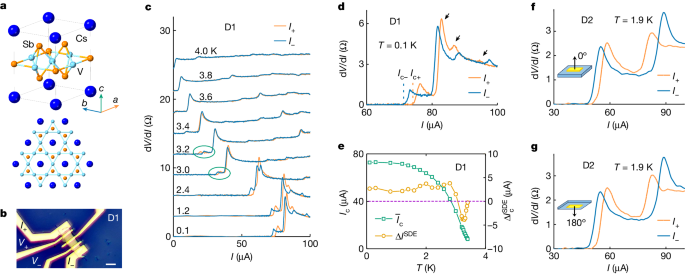Superconducting Diode Effect and Interference Patterns Observed in Kagome CsV3Sb5 Compound
Core Concepts
The CsV3Sb5 compound exhibits a superconducting diode effect and interference patterns in its critical current, suggesting the presence of dynamic superconducting domains with boundary supercurrents and time-reversal symmetry breaking.
Abstract
The content discusses the intriguing superconducting properties observed in the kagome compound CsV3Sb5. Key highlights:
The CsV3Sb5 compound (where A = Cs, K, or Rb) exhibits a cascade of symmetry-breaking transitions, including charge ordering, electronic nematicity, roton pair density wave, and superconductivity.
The nature of the superconducting order in CsV3Sb5 is not yet fully resolved. The authors report evidence of dynamic superconducting domains with boundary supercurrents in intrinsic CsV3Sb5 flakes.
A magnetic field-free superconducting diode effect is observed, with the polarity modulated by thermal histories. This suggests the presence of dynamic superconducting order domains in a spontaneous time-reversal symmetry-breaking background.
The critical current of CsV3Sb5 exhibits double-slit superconductivity interference patterns when subjected to an external magnetic field. The characteristics of these patterns are modulated by thermal cycling.
The authors propose that these phenomena are a consequence of periodically modulated supercurrents flowing along certain domain boundaries, constrained by fluxoid quantization.
The results imply a time-reversal symmetry-breaking superconducting order in CsV3Sb5, opening the potential for exploring exotic physics, such as Majorana zero modes, in this intriguing topological kagome system.
Superconducting diode effect and interference patterns in kagome CsV3Sb5 - Nature
Stats
The CsV3Sb5 compound exhibits a cascade of symmetry-breaking transitions, including charge ordering, electronic nematicity, roton pair density wave, and superconductivity.
Quotes
"The nature of the superconducting order is yet to be resolved."
"The magnetic field-free superconducting diode effect is observed with polarity modulated by thermal histories, suggesting that there are dynamic superconducting order domains in a spontaneous time-reversal symmetry-breaking background."
"Strikingly, the critical current exhibits double-slit superconductivity interference patterns when subjected to an external magnetic field."
Key Insights Distilled From
by Tian Le,Zhim... at www.nature.com 05-15-2024
https://www.nature.com/articles/s41586-024-07431-y
Deeper Inquiries
How do the dynamic superconducting domains and boundary supercurrents in CsV3Sb5 arise from the interplay between frustrated lattice geometry, non-trivial band topology, and electronic correlations?
The dynamic superconducting domains and boundary supercurrents in CsV3Sb5 are a result of the intricate interplay between various factors. The frustrated lattice geometry of the kagome structure creates a unique environment where electron interactions are highly influenced by the geometric arrangement of atoms. This frustration leads to the emergence of exotic quantum states due to the inability of the system to satisfy all competing interactions simultaneously.
Additionally, the non-trivial band topology of CsV3Sb5 plays a crucial role in shaping its electronic properties. The band structure of the material exhibits interesting features such as Dirac cones or topologically protected surface states, which can give rise to unconventional phenomena. When combined with strong electronic correlations, arising from the proximity to the Mott insulating state, these non-trivial band characteristics can lead to the formation of superconducting domains with unique properties.
The electronic correlations in CsV3Sb5 enhance the effects of frustration and band topology, promoting the formation of superconducting order with time-reversal symmetry-breaking characteristics. The boundary supercurrents observed in the material are a consequence of the competition between different ground states and the presence of topological defects in the lattice structure. Overall, the dynamic superconducting domains and boundary supercurrents in CsV3Sb5 are a direct result of the intricate interplay between frustrated lattice geometry, non-trivial band topology, and electronic correlations.
What are the implications of the time-reversal symmetry-breaking superconducting order in CsV3Sb5 for the potential emergence of exotic phenomena, such as Majorana zero modes?
The time-reversal symmetry-breaking superconducting order observed in CsV3Sb5 has profound implications for the emergence of exotic phenomena, particularly Majorana zero modes. Majorana zero modes are quasiparticles that are their own antiparticles and exhibit non-Abelian statistics, making them potential building blocks for fault-tolerant quantum computing.
In the context of CsV3Sb5, the time-reversal symmetry-breaking superconducting order suggests the presence of unconventional superconductivity that can host Majorana zero modes at certain defects or boundaries within the material. These Majorana zero modes arise due to the topological nature of the superconducting order parameter, which can protect the localized modes from local perturbations.
By leveraging the unique properties of the time-reversal symmetry-breaking superconducting order in CsV3Sb5, researchers can potentially engineer and manipulate Majorana zero modes for quantum information processing applications. The presence of these exotic quasiparticles opens up avenues for exploring topological quantum computation and realizing fault-tolerant qubits based on their non-Abelian braiding statistics.
How can the observed superconducting diode effect and interference patterns in CsV3Sb5 be leveraged for the development of novel superconducting devices or the exploration of fundamental physics?
The observed superconducting diode effect and interference patterns in CsV3Sb5 offer exciting opportunities for both the development of novel superconducting devices and the exploration of fundamental physics.
From a device perspective, the superconducting diode effect, where the polarity of supercurrents is modulated by thermal histories, can be harnessed for creating superconducting switches or rectifiers with tunable functionalities. By controlling the thermal cycling of the material, one can manipulate the direction and magnitude of supercurrents, enabling the design of unconventional electronic circuits based on superconducting principles.
Furthermore, the interference patterns exhibited by the material in the presence of an external magnetic field provide a unique platform for studying quantum phenomena. The modulation of interference patterns by thermal cycling suggests the presence of periodically modulated supercurrents flowing along specific domain boundaries, constrained by fluxoid quantization. This phenomenon can be utilized to study the dynamics of superconducting vortices and their interactions with boundaries, shedding light on the fundamental properties of superconductivity.
Overall, the superconducting diode effect and interference patterns in CsV3Sb5 not only hold promise for the development of advanced superconducting devices but also offer a rich playground for exploring the underlying physics of complex quantum systems.
0
